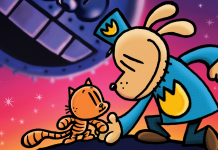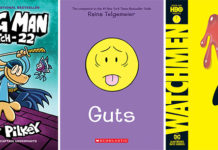As the end of the year approaches, it is commonplace to take a look back at the year, see where we’ve been, and if it foretells anything for the year ahead. I’m a bookseller and librarian, and this past year saw a continuing growth of comics in bookstores and specialty shops.

The New York Times samples both bookstores and comics shops, which is evident in the weekly lists. Bookstores tend to sell more literary titles, especially those well-reviewed. “Habibi”, published by Pantheon, was the number one title on the January 1 list, followed by Kate Beaton’s “Hark! A Vagrant”. “Twilight, Volume 2” charted at #7, two Tintin books (one a graphic novel biography) sold well due to the theatrical release, and Houghton Mifflin Harcourt’s “Best American Comic 2011” annual appeared for the sixth week and would chart for ten total. (The 2012 edition has also charted last month.)
Of course, comics shops influence the lists as well, driving first-week sales of many titles, many of them driven by sales of monthly comic books. The first week, DC’s $150 behemoth “DC comics: The New 52” charted at #3 (an amazing feat, given the price). “The Walking Dead: Book 1” appeared on the list for the 42 week, as did the holiday-themed “Batman: Noel” (from the bestselling creative team of “Joker”) and “Batman: The Black Mirror”.
So what’s what?
I won’t spoil it all here, but I will tell you this: there were seven different publishers with #1 titles in hardcover, six in paperback, and five on the manga charts. There was a publisher which dominated each list, but many suprises as well!
How well did DC do with the New 52 collections? How much do Vertigo and backlist titles account for DC’s bestselling titles?
What about kids and licensed properties? Does Hollywood affect graphic novels as much as it does the prose lists? (YES!)
There are cycles. Book publishers have strong Fall/Winter and Spring lists, which are also supplemented by reading lists. Summer is mostly dominated by media tie-ins and comic book publishers, as book publishers usually promote “beach reads” that season, leaving a big hole. This year, that hole was dominated by DC, both with Batman backlist and New 52 releases; and Image, with various Walking Dead volumes. The Winter titles (technically Fall, as the books are published long before December) tend to be gift items: large, beautiful books.
What does it all mean?
Well, comics have won. (DUH! The New York Times deems a GN bestseller list fit to print!) Bookstores, libraries, and comics shops are all selling lots of graphic novels, with many of those sales fueled by reviews, “Best Of” lists, and (YES!) college and high school reading lists. There are blockbuster movies (plural…remember when there might be ONE movie a year? Remember when that movie was “Supergirl” or “Howard the Duck”?) and cable television series serving as multi-million dollar advertisements for the source material.
Comics creators have won. Not only via Vertigo (which accounts for about a third of DC’s titles on the list), but at Marvel (Icon), book publishers (First Second, Pantheon), Drawn & Quarterly, Oni, IDW, Dark Horse… The corporate comics work-for-hire system is not the only way to make money in comics (although it has its benefits).
The comics shops have won, although a bit clumsily. Many are doing a fantastic job of selling a wide variety of titles, but look at the “non-traditional” #1 titles which charted. How many comics shops offer Tintin or Guy Delisle or America’s Best Comics or even a popular title like the MAD anniversary book? Some of that is to blame on clientele…a shop can’t take a risk on a non-returnable title (especially with an expensive hardcover) if the customers aren’t likely to buy it. Of course, a customer can’t buy what a store doesn’t have, so some of that is the fault of the manager or owner not trying to broaden the inventory. (Pre-orders, special orders, hand selling, library networking…)
Comics readers have won, in that titles are available everywhere, and it’s easy to discover new titles via RSS or web searching. (Ah…how I remember fondly thumbing through the green paperbacks of the Reader’s Guide to Periodical Literature, searching for the rare article about “comics books, strips, etc.”!) Libraries actively promote graphic novels, a popular category which boosts circulation figures, via reading groups, activities, and outreach. A curious reader can visit the local bookstore (almost as rare as comics shops!) and browse. (That’s how I discovered Matt Groening five years before “The Simpsons”! As well as “Bloom County”, “Maus”, Elfquest, Garfield, back in the 1980s.) Or they can go online.
Next year…?
The Walking Dead will continue to sell lots of books, many of them expensive. The paperback compendiums, each containing 48 issues, continue to sell forever, even better than the single volumes, which chart for a few weeks. Volume 1 of the trade paperback collection has now surpassed Watchmen as the paperback title with the most appearances on the charts.
Will DC dominate the hardcover list next year? The second volumes of the New 52 might chart, but for how long? With Vertigo being relegated editorially, will there be new titles added to the catalog, or will DC be forced to repackage backlist as deluxe editions and omnibuses?

Marvel had a bit of success with a movie tie-in to the Avengers, but lacks a strong backlist of titles for Iron Man 3. Marvel doesn’t do self-contained volumes of superheroes, no “What If” stories, unlike DC’s “Dark Knight Returns” or “The Joker”. Their “Season One” volumes might correct this, but those are new, and there is little backlist.
Will Marvel get its act together, perhaps replicating DC’s New 52 success with Marvel Now collections; or might Disney take some toys away from Scrooge and company and give them the budget dollars they need to succeed over at Disney Publishing? Disney has already acquired Lucasfilm, and is rumored to be in talks with Hasbro. If Marvel drives licensing and programming, might a more kid-friendly editorial directive be enforced? Or might Disney license comics properties to other publishers if Marvel is not adept?
Young readers are already a valuable market, as Manga proved shortly after the Millennium. While the Manga segment has shrunk from the gold rush days of Pokemon and Yu-Gi-Oh, kids continue to buy and read comics, especially in book form. Roughly half of the trade paperback bestsellers are titles aimed at a young audience, and even a few hardcover titles like Twilight and Courtney Crumrin sell well enough to compete. Of course, teenagers read widely, so some of the hardcover titles like Scott Pilgrim or The Walking Dead might be purchased by them as well. As comics become even more widely available via tablets, the youth market might become even more influential.
Of course, what happens to all those kids who read comics? Do they get hooked and continue to read and talk comics, becoming future creators and bloggers? Do they dabble in the medium, like most adult readers? Or is it boxed away into the attic, to be occasionally illuminated by the soft blue light of nostalgia?
I guess it doesn’t matter… there will always be new readers, and great titles to recommend to them. The titles may change from week to week, but there will always be a “bestseller” title.
More to follow…








RT @Comixace: Analysis: New York Times Bestsellers: Graphic Books: 2012: Overview: A year-end analysis, the introduction http://t.co/M2a …
RT @Comixace: Analysis: New York Times Bestsellers: Graphic Books: 2012: Overview: A year-end analysis, the introduction http://t.co/M2a …
Hannah Menzies liked this on Facebook.
RT @Comixace: Analysis: New York Times Bestsellers: Graphic Books: 2012: Overview: A year-end analysis, the introduction http://t.co/M2a …
Great post, Torsten, with some really big questions and observations. I don’t think any facet of the publishing industry has become disinter-mediated as quickly or creatively as comics. Part of what makes it the exciting world to work in these days.
Comments are closed.